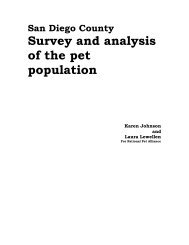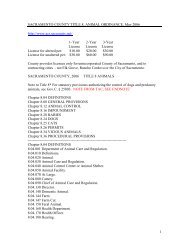Page 1 of 330 The Monthly National Legislation Report 7/5/2010 ...
Page 1 of 330 The Monthly National Legislation Report 7/5/2010 ...
Page 1 of 330 The Monthly National Legislation Report 7/5/2010 ...
You also want an ePaper? Increase the reach of your titles
YUMPU automatically turns print PDFs into web optimized ePapers that Google loves.
<strong>The</strong> <strong>Monthly</strong> <strong>National</strong> <strong>Legislation</strong> <strong>Report</strong>http://mnlreport.typepad.com/<strong>Page</strong> 67 <strong>of</strong> <strong>330</strong>7/5/<strong>2010</strong>HB140 - deadHB487- A BILL to amend and reenact § 29.1-501 <strong>of</strong> the Code <strong>of</strong> Virginia, relating to the Board <strong>of</strong> Game and Inland Fisheries; regulatory authority. Expands the authority <strong>of</strong> the Board <strong>of</strong> Gameand Inland Fisheries to adopt regulations on the feeding <strong>of</strong> any game, game animals, or furbearing animals. Currently, the Board has the authority to adopt regulations pertaining to the hunting,taking, capture, killing, possession, sale, purchase, and transportation <strong>of</strong> any wild bird, wild animal, or inland water fish.WASHINGTONHB2806/SB6299 (revised)- An act relating to animal inspections.Passed SenateSB6566- AN ACT relating to criminal <strong>of</strong>fenses involving animals or natureal resources. Prohibiting terrorist acts against animal and natural resource facilities.WEST VIRGINIAHB4407 - A BILL to amend and reenact §19-20A-2 and §19-20A-5 <strong>of</strong> the Code <strong>of</strong> West Virginia, 1931, as amended; and to amend said code by adding thereto a new section, designated §19-20A-4a, all relatingto rabies vaccination <strong>of</strong> dogs and cats; requiring that administered rabies vaccinations be capable <strong>of</strong> producing immunity for three years; requiring dogs and cats to be revaccinated every three years; andallowing for letters <strong>of</strong> exemption from rabies vaccination for medical reasons.WISCONSINAB747 - An Act to amend 813.12 (3) (a) (intro.), 813.12 (4) (a) (intro.), 813.122 (4) (a) (intro.), 813.122 (5) (a) (intro.), 813.125 (3) (a) (intro.), 813.125 (4) (a) (intro.), 951.01 (2), 951.13(intro.), 951.13 (2), 951.15, 951.18 (1) and 951.18 (4) (c); and to create 948.057, 951.18 (1m), 951.18 (1r) and 951.18 (4) (d) <strong>of</strong> the statutes; relating to: crimes against animals and providing apenalty.AB793/SB580 - An Act relating to: animals taken into custody.Sturgeon Bay - City Commission members are considering a ban on "pit bulls" stating they want to be "proactive" and to "err on the side <strong>of</strong> caution." A proacive ordinance would includemeasures to educate dog owners on responsible dog ownership, as well as tough penalties for owners who are not responsible with their dogs -- regardless <strong>of</strong> the breed <strong>of</strong> dog they own.<strong>The</strong> ordinance encompasses everything from pot-bellied pigs to beekeeping in the city limits, but the pit bull ban is the most contentious. UPDATE (02/19/10) <strong>The</strong> city has decided to rewrite theproposed animal ordinance to remove the breed-specific ban.Comments (0) | TrackBack (0)February 04, <strong>2010</strong>JANUARY, <strong>2010</strong>WELCOME TO <strong>2010</strong> !!!We SAID "not guilty!"If experts cannot ID dog breeds, how can cities?By Bill JohnsonDenver Post Columnist12/16/2009 01:00:00 AM MSTSo you think you know about dogs? Sorry, you do not.I break this news to you only because I got put to such a test Tuesday, along with about two dozen animal-shelter directors, volunteers, dog trainers and others who make a dog-relatedliving. <strong>The</strong> task was simple: View 20 dogs on a videotape and identify each one. Is it purebred or mixed? If believed a mix, what is the mixture <strong>of</strong> each? How hard could it be?All I know about dogs, I quickly learned, is that one lives with me. Of the 20 dogs shown, I got the breed correct one time, but only because it looked like Lupe, my mutt. I did only slightlyworse than the pr<strong>of</strong>essionals. "I was completely wrong. I probably got three to four out <strong>of</strong> the 20," claimed Laurie Buffington, a Berthoud dog trainer, as we left a classroom at the LongmontHumane Society."Think you can tell just by looking?" was the teaser for the breed identification study we participated in. It was run by Victoria L. Voith, a pr<strong>of</strong>essor <strong>of</strong> animal behavior in the College <strong>of</strong>Veterinary Medicine at Western University in Pomona, Calif. What I and the others ultimately learned is you cannot simply look at a dog and know what it is.Shelter workers, she explained, are generally 75 percent wrong when they list or tell you the breed <strong>of</strong> a dog. <strong>The</strong> only sure-fire way <strong>of</strong> knowing, she said, is DNA testing. "I started this study,"Voith said, "because I am a lover <strong>of</strong> German shepherds and was appalled that every short-haired breed with brown hair was called a German shepherd. It simply isn't so."Outside <strong>of</strong> the Lupe-looking Chihuahua-mix, I thought every dog looked like a pit bull or a shepherd-mix. "So what in the hell is Lupe?" I jotted in frustration in my notebook about halfwaythrough the session. I was not getting even remotely close. My favorite <strong>of</strong> all was the 20th dog, a three-legged cutie that had been thrown from a car. She was not the English sheepdog Isuspected, but a shih-tzu. Everyone else misidentified her too.Through her work, Voith hopes to put to the lie two things: studies on which dogs bite the most, and the wisdom <strong>of</strong> municipal breed-specific bans, such as Denver's, where hundreds <strong>of</strong>suspected pit bulls have been put to death. "Visual identification simply is not in high agreement with DNA analysis," she said when I protested that a dog I had falsely, dead-to-rightsidentified as a pit bull turned out through DNA testing to be mostly Dalmatian. "Dogs in Denver may be dying needlessly," she said. She hopes that her work, which she expects to bepublished in a year, will better inform cities and statistics gatherers on breeds most likely to bite. "We really don't know yet. I don't think we have ever really known," she said.<strong>The</strong> pr<strong>of</strong>essionals all walked out scratching their heads, each mumbling something akin to "that was very informative!" "I always thought I was really good at identifying breeds," a chastened




